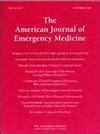When is brain MRI indicated for children with the first unprovoked seizure presenting to the pediatric emergency department? A retrospective cohort study
IF 2.2
3区 医学
Q1 EMERGENCY MEDICINE
引用次数: 0
Abstract
Background
The decision to perform immediate brain magnetic resonance imaging (MRI) in children with their first unprovoked seizure presenting to the emergency department (ED) remains a clinical challenge. We aimed to identify clinical factors associated with the detection of epileptogenic lesions and emergent neuroimaging findings on MRI to determine the imaging necessity and urgency, respectively.
Methods
We retrospectively enrolled pediatric patients (age 0–18 years) presenting to a single institution's pediatric ED with new-onset unprovoked seizures between January 2010 and December 2023.
Results
Among 222 included children, 84 (37.8 %) demonstrated an epileptogenic lesion, among which 18 (21.4 %) exhibited emergent neuroimaging findings. Multiple seizures at presentation (p < 0.001), prolonged seizures lasting ≥5 min (p < 0.001), and developmental delay (p < 0.001) were significantly associated with epileptogenic lesions. Classification of patients with one or more risk factors as the high-risk group showed a sensitivity of 94.0 % and specificity of 55.1 % for detecting epileptogenic lesions, and a sensitivity of 100 % and specificity of 39.7 % for emergent neuroimaging findings. In patients without any of these risk factors, only 5 of 81 patients (6.3 %) had epileptogenic lesions, and none had emergent neuroimaging findings.
Conclusion
Among patients with new-onset unprovoked seizures visiting the pediatric ED, those with one or more risk factors—multiple seizures, prolonged seizure duration, or developmental delay—may benefit from MRI to identify epileptogenic lesions. Our findings suggest that low-risk patients rarely have urgent lesions and emergent MRI might be deferred; however, prospective multicenter validation is needed before implementing this approach.
在儿童急诊科首次出现非诱发性癫痫时,什么时候需要进行脑MRI检查?回顾性队列研究
背景:在急诊科(ED)首次出现非诱发性癫痫发作的儿童中,决定立即进行脑磁共振成像(MRI)仍然是一个临床挑战。我们的目的是确定与检测癫痫性病变和紧急MRI神经影像学结果相关的临床因素,分别确定影像学的必要性和紧迫性。方法回顾性纳入2010年1月至2023年12月间在同一医院儿科急诊科出现新发非诱发性癫痫的儿童患者(年龄0-18岁)。结果222例患儿中,84例(37.8%)表现为癫痫性病变,其中18例(21.4%)表现为紧急神经影像学表现。出现时多次癫痫发作(p <;0.001),持续≥5分钟的癫痫发作延长(p <;0.001),发育迟缓(p <;0.001)与癫痫性病变显著相关。将具有一种或多种危险因素的患者分类为高危组,检测癫痫性病变的敏感性为94.0%,特异性为55.1%,对紧急神经影像学发现的敏感性为100%,特异性为39.7%。在没有这些危险因素的患者中,81例患者中只有5例(6.3%)有癫痫性病变,没有出现紧急神经影像学发现。结论在儿科急诊科就诊的新发非诱发性癫痫患者中,那些具有一种或多种危险因素(多次发作、发作持续时间延长或发育迟缓)的患者可能受益于MRI识别癫痫性病变。我们的研究结果表明,低风险患者很少有紧急病变,紧急MRI可能被推迟;然而,在实施这种方法之前,需要进行前瞻性的多中心验证。
本文章由计算机程序翻译,如有差异,请以英文原文为准。
求助全文
约1分钟内获得全文
求助全文
来源期刊
CiteScore
6.00
自引率
5.60%
发文量
730
审稿时长
42 days
期刊介绍:
A distinctive blend of practicality and scholarliness makes the American Journal of Emergency Medicine a key source for information on emergency medical care. Covering all activities concerned with emergency medicine, it is the journal to turn to for information to help increase the ability to understand, recognize and treat emergency conditions. Issues contain clinical articles, case reports, review articles, editorials, international notes, book reviews and more.

 求助内容:
求助内容: 应助结果提醒方式:
应助结果提醒方式:


